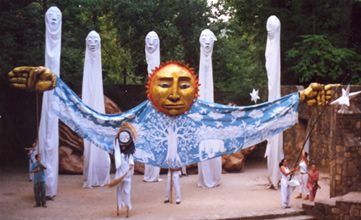I have to say, this fall season of theatre in the Triangle has turned out to be a very singular season, indeed. After experiencing several exceptional presentations prior to this weekend, I was thrilled to come to a “tried and true” performance of Lerner and Loewe’s Camelot at Burning Coal. Up until this moment, I had witnessed in this season: reincarnation, in the form of Carolyn Adams at the ArtsCenter, the unique experience of traveling cross-country in a shipping container, in Burning Coal’s The Container, and the most moving and dynamic showing of Ragtime, at PlayMakers, that I have ever seen. But Burning Coal had one more surprise for me to close out what has been a most, shall we say, unique season.
I have known many different interpretations of the King Arthur legend, ranging from a young squire pulling a sword from a stone to watching an old king, still hale and on the throne, divvying out his particular form of justice as his rule comes to a close. While there are as many interpretations of the reign of King Arthur as there are poets, playwrights, and novelists to articulate it, I was nonetheless a touch taken aback at this distinctly unique interpretation of the fairly well known goings-on in Camelot.
The story of King Arthur – his wedding to a designated bride he had never before seen, and the unfortunate tryst developing between his bride and his best friend – is a universally-known series of events. The Knights of the Round Table are known the world over, captured in as many tales as can be squeezed between the covers of a book. Lerner and Loewe’s own work has been re-interpreted again and again, expanded and delved into and restaged. My first introduction to the events in Camelot came in the form of film. A mighty king, a new and bewitching bride, and a singularly uncommon knight caught my eye years ago, and I was hooked from then on. King Arthur has always had a way of pricking up my ears and drawing my attention. But this new interpretation left me just a touch unsettled.
In the opening scene of Burning Coal’s Camelot, we are met by a young man up a tree. He has taken this position in order to obtain both a hiding spot and a vantage point. His bride, you see – or, more to the point, his bride’s carriage – is approaching the castle, and Arthur (Galen Murphy-Hoffman) is attempting to catch a glimpse of her. But Merlin (dashingly played by Julie Oliver) finds Arthur in his hiding place and brings him down to earth, both literally and figuratively. The part I was unprepared for, the interpretation I find so singular, is the character of Arthur himself.
Arthur is still a young man; I expected this. He is somewhat brash and inexperienced; I expected this, as well. What I wasn’t ready for – what I still cannot get my head around – was the, um, shall we say, unique interpretation that Arthur is uncommonly simple. Simple in the regard that his thought processes are somewhat nebulous. This is an aspect of the Arthurian Legend for which I was simply not prepared.
It is folly to try to compare a stage production of a show to its cinematic counterpart. Apples and oranges, as it were. But my first cinematic experience of Arthur was Richard Harris. Harris is a man who has a very long list of well-known attributes to bring to his character, but simple has never been one of them. Here we meet a man who seems incapable of keeping two distinct thoughts in his head. I was thunderstruck. If ever there was a character flaw that could keep a man off the throne, simple might very well be it. So I was about to embark down a path I had never before traversed.
Burning Coal brings a number of new and entertaining, if somewhat outré, aspects to the current interpretation of Camelot. Instead of an orchestra, for example, we have an instrumental trio (guitar, keyboards, and drums). Well, that’s new. Minimalist accompaniment was never a hallmark of this tale before now. But BC makes it work, thanks in no small part to the somewhat more modern feel of the arrangements created by Thomas Goldsmith.
. I could not have conceived of Lancelot (Tyler Graeper) singing “If Ever I Should Leave You” to Guenevere (Natalie Reder) to a rock beat, but it worked! I confess myself confounded. And the singular aspect of weaponry being red (and I’m talking red) lengths of pipe (short for swords, long for lances) was again, singular. It smacks of blood already stained in the shaft. Very singular. Only Arthur’s already singular Excalibur was depicted as an actual sword. This, again, re-emphasized the singular aspect of this weapon and its place in King Arthur’s narrative. There are so many different aspects of Burning Coal’s work that shed new light. As the show progressed, I found myself opening up to this new interpretation, taking it in and seeing where it would take me. The openly hostile demeanor of Mordred (Shawn Morgenlander), the insanity of Morgan Le Fay (excellently portrayed by AC Donohue), the seeming beneficence (but inner strength) of Pellinore (Alec Donaldson) – all of these aspects were new and shining to me.
As Arthur and his connections with wife, friend, and enemy unfolded, I was also beginning to see how this idea of Arthur’s simple approach was weaving itself into the narrative. Was this Arthur’s fatal flaw? Was this almost childlike approach to rule the singular thing that brought Camelot down around Arthur’s ears? It was an intriguing situation. Even the courtroom drama of the sentencing of Guenevere, or the offstage depiction of Lancelot’s return to save his queen, were done simply, as narrative, sung by a single voice (Lee Jean, Jr.). All of this was weaving its spell on me. As the final scene progressed and Arthur knighted the young boy, Tom, to send him on his mission, even though all of this was a known quantity to me, I found that lump forming in my throat at the passing of this one brief, shining moment. Burning Coal has managed to do it to me yet again, even in its presentation of already well-known fare. They all snuck up on me, and they got me. It was masterful.
Director Jerome Davis‘ reinterpretation of Camelot puts the entire legend in a different light. Everything we expect to happen, happens. But the unique and unsettling approach to this longtime favorite chestnut made it new again, and Burning Coal’s individual and unique style shone through. This old story comes to us in a new guise, and it is as entertaining as it is minimalist. I doff my hat once more to Mr. Davis and his company. This is not your mother’s Camelot, and it is all the more enjoyable for the change.
Camelot continues through Sunday, December 22. For more details on this production, please view the sidebar.
Edited/updated 12/20/19.













